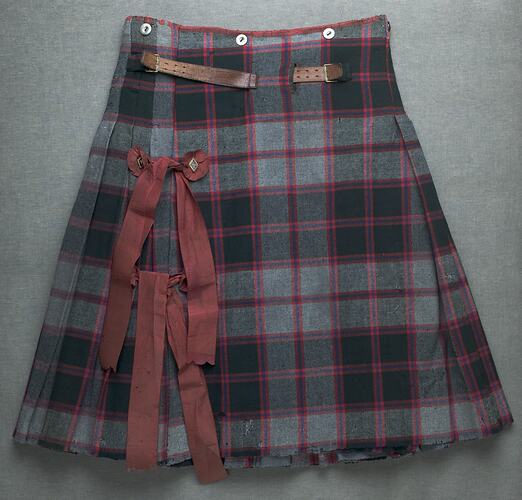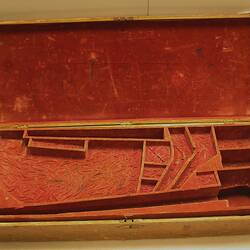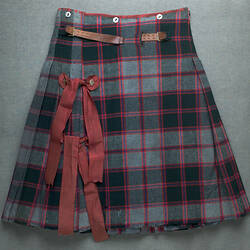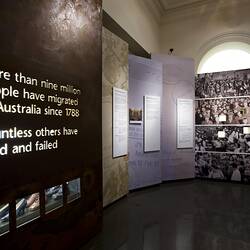Summary
Scottish regalia kit in a velvet-lined wooden trunk, brought to Australia by Dugald McPherson (1820-1901), who arrived in Victoria in 1840 aged 20 with his brother Peter, bringing with him a trunk of Scottish regalia. The trunk contained at the time of donation to Museum Victoria:
McPherson hunting tartan (kilt)
Shawl
Glengarry (highland cap)
Glengarry (highland cap)
Dirk & sheath, bearing McPherson crest (cat), cairngorm stone in hilt
Dirk & sheath with knife & fork in sheath, cairngorm stone in hilt
Sgian dhu (ceremonial dagger) & sheath with crest
Broadsword with leather grip & ironwork knuckleguard with crest, in scabbard (chape missing)
Shoulder brooch with thistle design & large cairngorm in centre
Belt with buckle
Belt with buckle
Belt
Shoe buckle
Shoe buckle
Buckle with full crest with cat & slogan 'touch not the cat but the glove'.
The kit may have originally contained other objects, since many of the compartments in the trunk do not fit the objects acquired by the Museum.
Dugald McPherson was a pioneer squatter who first settled at Ballan, north-west of Melbourne, and subsequently developed huge landholdings in north-western Victoria, New South Wales and Queensland. A stalwart of the Scottish immigrant community, Dugald was chief of the Highland Society of Ballarat and an elder of the Presbyterian Church. With other wealthy pastoralists, he later helped form the Australian Club in William Street.
Dugald's mother had been a McKellar, with later family connections to the Western District. Dugald's second son Arthur married Annie Fawkner, a daughter of John Fawkner. In 1861, William Wills, father of William John Wills of Burke & Wills fame, stayed briefly with Dugald during the agonizing wait for his missing son.
The regalia was passed onto Dugald's youngest son John (aka Jack). It was subsequently passed to Dugald's great-great-granddaughter, Hope Macpherson, a long-time employee of Museum Victoria. Hope says that the family remembered Dugald as very interested in his Scottish heritage and 'land-hungry'. A revolver also apparently used by Dugald is also held in Museum Victoria's collection.
Physical Description
Large rectangular wooden trunk with hinged lid, and lined with velvet. Contains a shelf divided into compartments for specific parts of the kit, including a sword, knives and belts. The shelf lifts out to reveal an undivided storage area, probably used to store the kilt and sash. The trunk has a lock at the centre front, a swinging brass catch at each corner at the front, dovetail joints and three brass hinges.
More Information
-
Collection Names
-
Collecting Areas
Arms, Migration & Cultural Diversity, Public Life & Institutions, Clothing & Textiles
-
Acquisition Information
Donation from Miss Hope Macpherson - National Museum of Victoria, Nov 1962
-
User
Dugald McPherson, Ballan, Victoria, Australia, 1840-1901
Dates of use based on date of user's immigration to Australia and date of death. -
Place & Date Made
Scotland, Great Britain, pre 1840
Latest date based on the fact that the user left Scotland with the regalia in 1839, arriving in Victoria in January 1840. -
Classification
-
Category
-
Discipline
-
Type of item
-
Overall Dimensions
109 cm (Length), 42 cm (Width), 19.5 cm (Height)
Trunk measurements 57.5cm high when open.
-
Keywords
Immigration, Militaria: Scottish, Scottish Communities, Scottish Cultural Activities, Scottish Immigration, Kilts, Tartan






